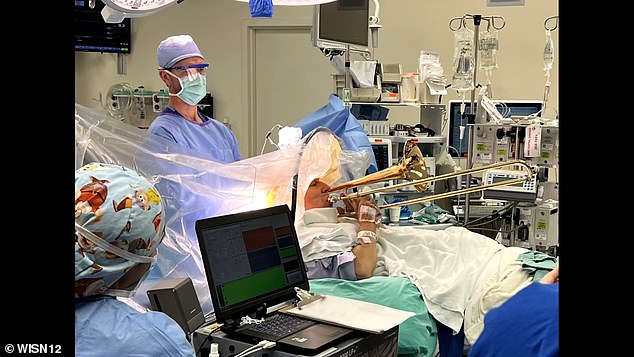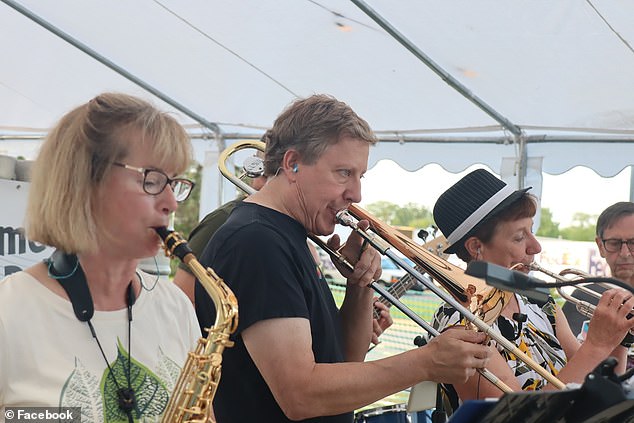Astonishing video shows brain surgery patient playing trombone while doctors operate
A Wisconsin patient who underwent brain surgery shocked doctors when he played his trombone during surgery to make sure the procedure was working.
Brian Rust noticed that his hand was shaking severely, which made it difficult for him to play the trombone and hold his grandchildren.
He has been playing trombone since he was 15 years old and in high school.
Doctors diagnosed Rust with an intention tremor, an involuntary muscle contraction that occurs during voluntary movement. They prescribed medication and scheduled physical therapy.
When those methods no longer worked, he was scheduled for brain surgery at UW Health in Madison, Wisconsin
Doctors in Wisconsin have diagnosed Brian Rust with an intentional tremor — an involuntary muscle contraction that occurs during voluntary movement — after his shaking hands made it difficult to play his beloved trombone and hold his grandchildren.

Rust was scheduled to undergo brain surgery in November 2022 at UW Health in Madison, Wisconsin, with neurosurgeon Dr. Wendell Lake
Rust told WISN-TV: ‘There is nothing that compares to the feeling of playing with other people and making music. It’s really hard to describe.
‘Even if you don’t play that well, it’s still a great feeling. I don’t want to give up that feeling yet.’
The neurosurgeon who operated on Rust was Dr. Wendell Lake, who performed the surgery in November 2022. Rust would have to remain awake during the procedure, so he asked the doctor if he could take the trombone into the operating room with him.
For Lake it was a first. Other patients had brought writing tablets, but never a musical instrument.
In the video, Rust doesn’t actually blow into the instrument to produce sound. Instead, he pushes the trombone’s outer slide outward as doctors watch to see if the tremors in his hand were corrected during the surgery.

The surgery required Rust to remain awake, so he asked Lake if he could take the trombone into the operating room. PICTURED: Dr. Wendall Lake (left) and Brian Rust (right)

By using the trombone Rust played as a visual indicator, doctors were able to adjust the position of the wires and how much electrical current he had to use to keep his hand still. PICTURED: Rust playing with his dance band Six Thirty Sharp

Rust’s surgery was a success and he now performs regularly with his dance band Six Thirty Sharp in McFarland, Wisconsin
Lake asks Rust questions to test what he feels during the video.
‘Do you also feel a little bit of that cold or that tingling sensation in your hand, Brian?’
When doctors watched Rust operate the trombone, they were able to adjust the position of the wires and determine how much electrical current to use to keep his hand still.
The specific type of surgery Rust underwent is called deep brain stimulation, a surgical procedure that uses electrical stimulation to treat neurological disorders.
Typically, wires are connected to a neurostimulator that generates electricity. It is then implanted under the person’s collarbone, similar to a pacemaker.
Once the connection is made, the electrical current from the neurostimulator travels through the wires to the brain.
Doctors then program the device to deliver an electrical signal several weeks after surgery.
This surgery is used to treat movement disorders such as Parkinson’s disease, dystonia and tremors, according to John Hopkins Medicine.
Rust has a smartphone that controls the neurostimulator that is placed under his collarbone. It has two modes: one for daily functions and the other for playing his trombone.
Rust now performs regularly with his dance band Six Thirty Sharp in McFarland, Wisconsin.
